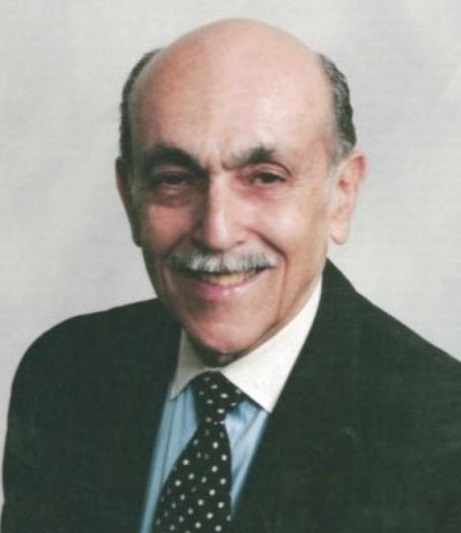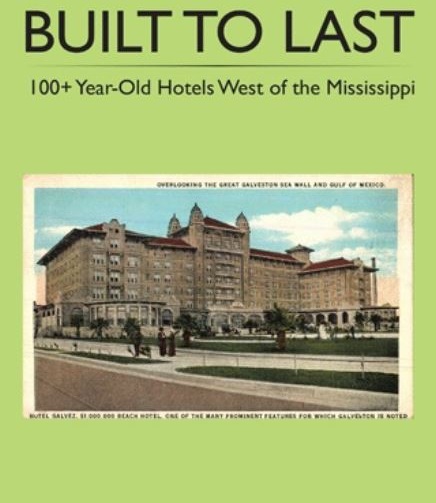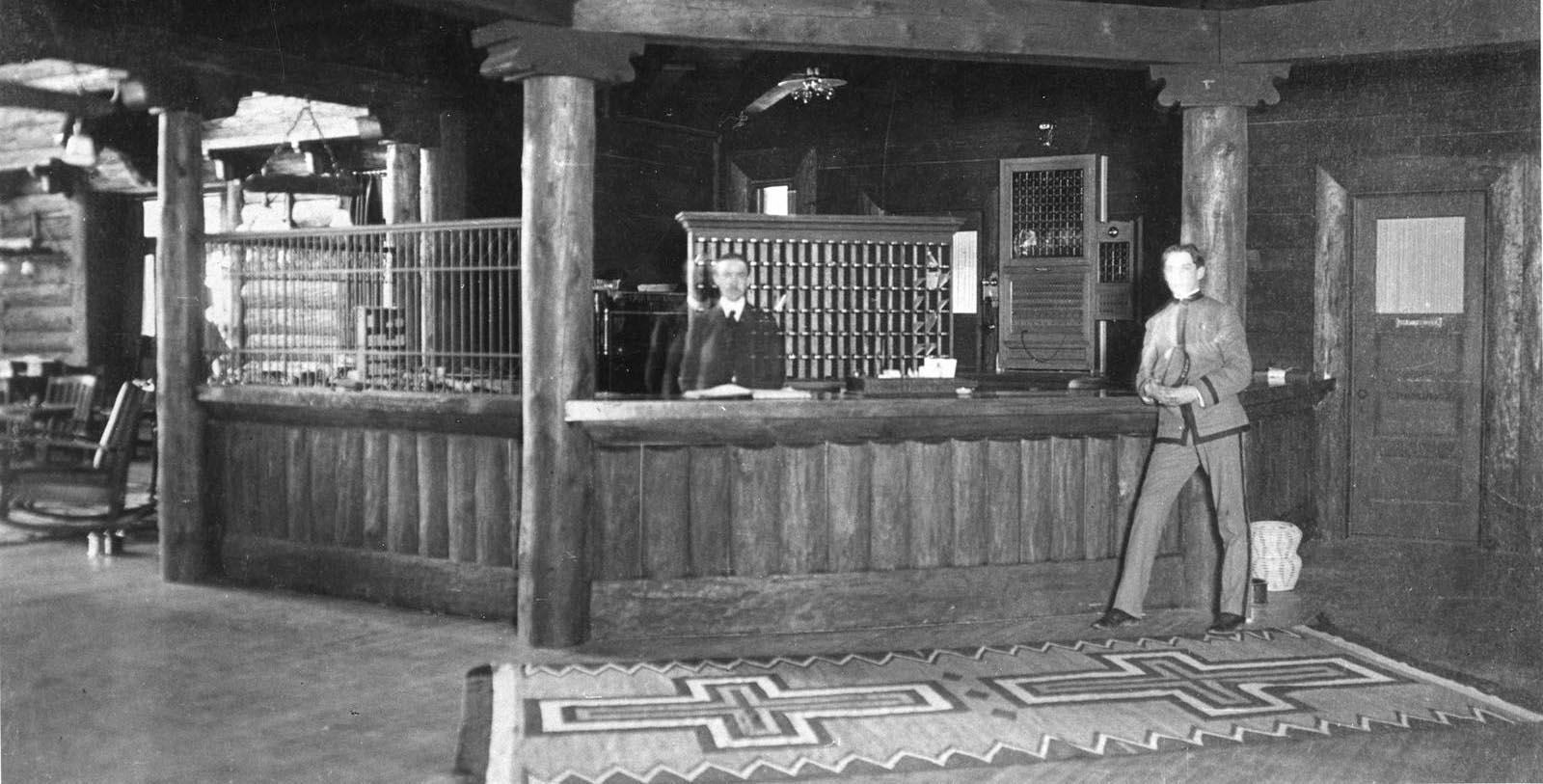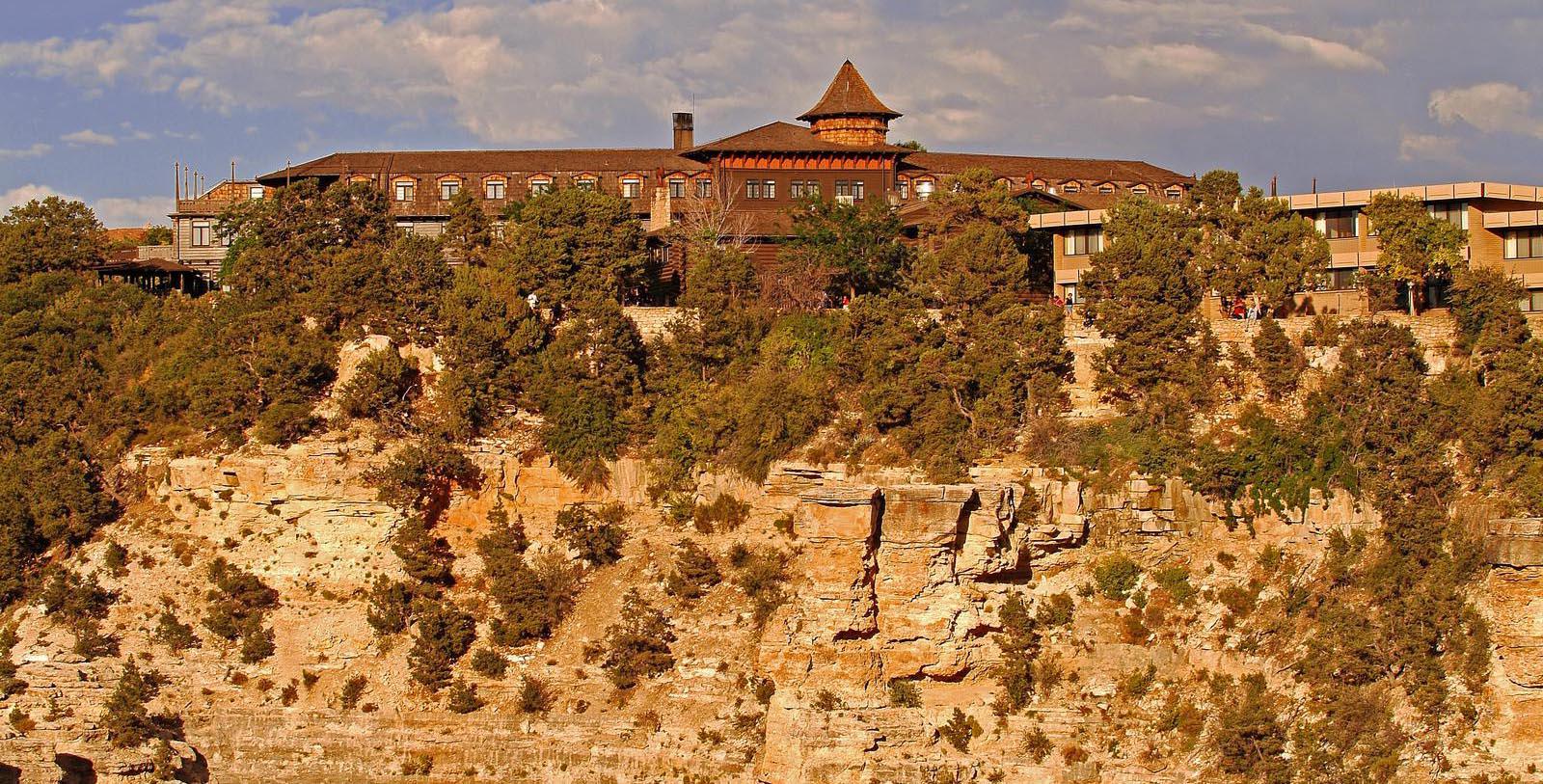Receive for Free - Discover & Explore eNewsletter monthly with advance notice of special offers, packages, and insider savings from 10% - 30% off Best Available Rates at selected hotels.
history
Discover El Tovar Hotel, which is the premier lodging facility at the Grand Canyon National Park where President Theodore Roosevelt stayed.
El Tovar Hotel, a member of Historic Hotels of America since 2012, dates back to 1905.
VIEW TIMELINEA U.S. National Historic Landmark, the El Tovar Hotel is among the most cherished holiday retreats in all Arizona. This spectacular historic destination is located in the heart of historic Grand Canyon Village, which overlooks the expansive Grand Canyon National Park. (Grand Canyon Village is also identified as a U.S. National Historic Landmark, too.) The El Tovar Hotel itself dates back to a time when the Grand Canyon was rapidly emerging as one of the nation’s most celebrated natural landmarks. Countless Americans had started to visit the Grand Canyon in order to experience its majesty and wonder during the early 20th century, including U.S. President Theodore Roosevelt. As such, several entrepreneurs—including the leaders of the Atchison, Topeka, and Santa Fe Railway—decided to capitalize upon the region’s newfound popularity. The railroad began constructing a spur of its system into the Grand Canyon, in order to help accommodate the number of people interested in visiting the site. Taking months to complete, the new Grand Canyon Railroad finally made its much-anticipated debut in 1901. The Atchison, Topeka, and Santa Fe Railway then immediately partnered with the Fred Harvey Company to construct a quaint hotel that could cater to the prospective travelers that the railroad hoped it would serve. The two companies opted to use an Albuquerque-based architect employed by the Railway named Charles Whittlesey to oversee the hotel’s construction. He quickly set about designing the new structure with a budget of $250,000, creating a beautiful multi-story structure that mimicked both a Swiss chalet and Scandinavian hunting lodge.
To achieve such an appearance, he had utilized a combination of local limestone and Oregon pine to craft a rustic, log-cabin-like façade. But the brilliance of Whittlesey’s design did not only involve the building’s appearance—he also managed to install numerous cutting-edge facilities, like a barbershop, solarium, and greenhouse that featured all kinds of fresh produce. Whittlesey even successfully outfitted every one of the hotel’s nearly 100 guestrooms with plumbing, steam heat, and electric lights. Once Whittlesey finally finished the project in 1905, the Railway chose to name the building as the “El Tovar Hotel” after one of the first people to inspire the exploration of the Grand Canyon, Pedro de Tovar. (While Tovar encourage many contemporaries to seek out the Grand Canyon during the 16th century, interestingly, he never saw it himself.) The El Tovar Hotel quickly became an overnight sensation, with many thinking of it as the finest holiday destination open west of the Mississippi River. In fact, some of the most influential individuals in the world visited not long after the building’s debut, including George Bernard Shaw, Ferdinand Foch, and Guglielmo Marconi. An enthusiastic President Roosevelt even stayed at the El Tovar Hotel upon subsequent return trips to the Grand Canyon, eventually writing about his experiences in a book that he produced in 1913. Today, El Tovar Hotel still remains just as popular among contemporary visitors to the Grand Canyon. The site has been particularly adored by modern-day cultural heritage travelers, who have been fascinated with its gorgeous historical architecture, interesting institutional history, and unrivaled hospitality.
-
About the Location +
Considered one of the legendary “Wonders of the World,” the Grand Canyon is among the most iconic places to experience in the whole United States. The Grand Canyon is a gorgeous gorge cut into the Colorado River, made from five to six-million years’ worth of constant erosion. It is also massive—the entire natural landmark measures 277 miles in length, up to 18 miles in width, and a mile deep. In fact, the entire Grand Canyon covers more than 1.2 million acres of the Colorado Plateau in northwestern Arizona. Some of the most historic geological formations in the country are located in the Grand Canyon, too, with the most notable being the Vishnu Basement Rock. Dating back nearly two millennia, much of the stone has granted geologists the unprecedented ability to study the evolution of the North American continent. Despite the semi-arid climate that defines the geography, the Grand Canyon is nonetheless full of life. The site is the home of several major ecosystems, specifically the following five biomes: Canadian, Hudsonian, Transition, Lower Sonoran, and Upper Sonoran. As such, the Grand Canyon is subsequently home to over 500 unique species of animal, as well as more than 1,500 different types of plants. Many of those lifeforms are found in few other places around the world, including the bighorn sheep, mule deer, and bison. The profound amount of flora and fauna has even made the Grand Canyon a vast repository for distinctive fossils. Scientists have discovered countless fossils within the walls, like crinoids, brachiopods, and ancient insects. The local fossil record has also indicated that the Grand Canyon hosted life—albeit in a very different environment—as far back as the Precambrian Era!
The history of human interaction with the Grand Canyon is more recent comparatively, as the earliest Native Americans originally inhabited the location just a few hundred years ago. The first were the Ancestral Pueblo, who were then followed by the likes of the Paiute, Navajo, Hopi, and Cohonina. (In fact, some of those people continue to reside throughout the Grand Canyon today, such as the descendants of the Cohonina—the Yuman, Hualapai, and the Havasupai.) However, the local Native Americans were later visited by individuals of European ancestry centuries later, starting with the arrival of several Spanish conquistadors during the 1500s. American prospectors eventually began investigating the site for ore deposits of gold and copper following the Mexican-American War. Over time, word spread of the destination’s inherent beauty, which prompted the U.S. government to sponsor its own expeditions to the Grand Canyon. Perhaps the most famous journey undertaken was that of geologist John Wesley Powell, who created a comprehensive series of maps throughout the 1870s. (Powell was also the person responsible for giving the area the name “Grand Canyon.”) Amid the ongoing geological surveys of the Grand Canyon, a number of American pioneers began settling along a portion of its southern rim. While the pioneers were originally interested in mining, they gradually started building a vibrant local tourism industry centered on the Grand Canyon itself. They specifically offered guided tours into the lower segments of the Grand Canyon, and built their own hotels to cater to the new guests whom they entertained.
By the 1880s, the Grand Canyon had emerged as one of the country’s most popular tourist sites. The great interest in the Grand Canyon inspired Congress to try and preserve it as a national park, with Senator Benjamin Harrison sponsoring several bills throughout the Gilded Age. When those efforts were unsuccessful, Harrison decided to protect the Grand Canyon as reserve while serving as U.S. President in 1893. Another U.S. President—Theodore Roosevelt—further helped conserve the the Grand Canyon by declaring it a National Monument in 1908. But legislation to turn the Grand Canyon into a national park continued to languish in the U.S. Senate for many years thereafter. Thankfully, Congress finally managed to secure enough support to pass the Grand Canyon National Park Act, which President Woodrow Wilson signed into law in 1919. Grand Canyon National Park has since become one of the most popular sites within the National Park Service system. Indeed, the location hosted more than 4.5 million people alone in 2021. It is also considered one of the most culturally significant, receiving a coveted designation as a UNESCO World Heritage Site during the 1970s. Many of the park’s cultural attractions are split between two distinctive regions, the South Rim and the North Rim. An amazing assortment of hiking trails proliferate throughout each section, as do a number of spectacular spots to go sightseeing, biking, and rafting. Furthermore, the South Rim is home to several famous historic buildings, including the Hopi House, Lookout Studio, and the Desert View Watchtower. All are located within the Grand Canyon Village, a planned visitor community run by the National Park Service that bears a designation as a U.S. National Historic Landmark.
-
About the Architecture +
When Atchison, Topeka, and Santa Fe Railway commissioned Charles Whittlesey to construct the El Tovar Hotel, it grant him a budget of $250,000—worth more than $8.4 million today. It hoped that finances would grant Whittlesey the ability to craft a magnificent hotel that mimicked the grand destination resorts of Europe. Whittlesey did not disappoint. A beautiful three-story structure subsequently took shape over the span of three years, which loomed majestically over the nascent Grand Canyon Village. In keeping with the location’s rustic ambiance, the fledgling hotel mimicked the style of both a quaint Swiss chalet and a rugged Scandinavian hunting lodge. Whittlesey used a combination of Oregon Douglas fir and local limestone boulders to craft its outstanding façade. Much of the first level displayed an apt utilization of log siding as an homage to the earlier wooden cabins that once dotted the nearby landscape. Further atop the structure sat a number of deeply pitched mansard roofs complete with gorgeous, pierced dormers. Perhaps its most distinguishable feature was the central turret and its wrapped shingles that Whittlesey meant to house the hotel’s massive water tank. The rustic theme continued inside the structure, too, as the central lobby contained Swiss-inspired wooden railings and peeled log posts that were that were all varnished in a similar dark hue of brown. Interestingly, Whittlesey also incorporated several different architectural aesthetics in other interior spaces, including Mission Revival style and the Arts and Crafts Movement. The decision ultimately produced an eclectic character that better reflected the greater culture of the surrounding American Southwest. When the building thus debuted as the “El Tovar Hotel” in 1905, it unique architectural appearance succeeded in mesmerizing every single one of its new guests.
-
Famous Historic Guests +
Douglas Fairbanks, actor known for his roles in The Thief of Baghdad, Robin Hood, and The Mark of Zorro.
Mary Pickford, actress known for her role in the silent film Coquette.
Elizabeth Taylor, actress known for her roles in Cleopatra and The Taming of the Shrew.
George Bernard Shaw, playwright known for works such as Man and Superman, Pygmalion, and Saint Joan.
Ferdinand Foch, Supreme Allied Commander during World War I.
Guglielmo Marconi, an inventor of the radio who won the Nobel Prize in Physics in 1909.
Albert Einstein, Nobel Prize winning physicist known for his role in developing quantum theory.
Arthur Fiedler, conductor who famously worked with both the Boston Symphony Orchestra and Boston Pops Orchestra.
Theodore Roosevelt, 26th President of the United States (1901 – 1909)
William Howard Taft, 27th President of the United States (1909 – 1913) and 10th Chief Justice of the United States (1921 – 1930)
Calvin Coolidge, 30th President of the United States (1923 – 1929)
Herbert Hoover, 31st President of the United States (1929 – 1933)
Dwight D. Eisenhower, 34th President of the United States (1953 – 1961), and Supreme Allied Commander Europe during World War II.
Gerald Ford, 38th President of the United States (1974 – 1977)
George H.W. Bush, 41st President of the United States (1989 – 1993)
Bill Clinton, 42nd President of the United States (1993 – 2001)


Guest Historian Series
Read Guest Historian SeriesNobody Asked Me, But… No.257;
Hotel History: El Tovar 8 Hopi Gift Shop (1905)
By Stanley Turkel, CMHS
One hundred and sixteen years ago, two architectural jewels opened in the Grand Canyon National Park: the 95-room El Tovar Hotel and the adjacent Hopi House Gift Shop. Both reflected the foresight and entrepreneurship of Frederick Henry Harvey whose business ventures included restaurants, hotels, railroad dining cars, gift shops and newsstands. His partnership with the Atchison, Topeka and Santa Fe Railway introduced many new tourists to the American Southwest by making rail travel and dining comfortable and adventurous. Employing many Native-American artists, the Fred Harvey Company also collected examples of indigenous basketry, beadwork, kachina dolls, pottery and textiles. Harvey was known as the “Civilizer of the West.”
Long before the U.S. Congress designated the Grand Canyon National Park in 1919, the earliest tourists came via stagecoach and stayed overnight in tents, cabins or primitive commercial hotels. However, when the Atchison, Topeka and Santa Fe Railway opened a spur almost directly to the South Rim of the Grand Canyon, it created a shortage of adequate accommodations. In 1902, the Santa Fe Railway commissioned construction of El Tovar, a first-class four-story hotel designed by Chicago architect Charles Whittlesey with almost one hundred rooms. The hotel cost $250,000 to build and was the most elegant hotel west of the Mississippi River. It was named “El Tovar” in honor of Pedro de Tovar of the Coronado Expedition. Despite its rustic features, the hotel contained a coal-fired generator that powered electric lights, steam heat, hot and cold running water and indoor plumbing. However, since none of the guestrooms had a private bathroom, guests used a public bathroom on each of the four floors.
The hotel also had a greenhouse to grow fresh fruits and vegetables, a chicken house and a dairy herd to provide fresh milk. Other features included a barbershop, solarium, roof-top garden, billiard room, art and music rooms and Western Union telegraph service in the lobby.
The new hotel was built before the Grand Canyon became a protected Federal national park following President Theodore Roosevelt’s 1903 visit to the Canyon. Roosevelt said, “I want to ask you to do one thing in connection with it in your own interest and in the interest of the country- to keep this great wonder of nature as it is now… I hope you will not have a building of any kind, not a summer cottage, a hotel or anything else, to mar the wonderful grandeur, the sublimity, the great loveliness and beauty of the Canyon. Leave it as it is. You cannot improve upon it.”
Fred Harvey’s restaurants were built almost every 100 miles along the Santa Fe Railway through Kansas, Colorado, Texas, Oklahoma, New Mexico and California. He staffed his restaurants and hotels with “Harvey Girls”, young women recruited across the U.S. with “good moral character, at least an eighth grade education, good manners, clear speech and a neat appearance.” Many of them later married ranchers and cowboys and named their children “Fred” or “Harvey”. Comedian Will Rogers said of Fred Harvey, “He kept the west in food and wives.”
The El Tovar was placed on the National Register of Historic Places on September 6, 1974. It was declared a National Historic Landmark on May 28, 1987 and is a member of Historic Hotels of America since 2012. The Hotel has hosted such luminaries as Albert Einstein, Zane Grey, President Bill Clinton, Paul McCartney, among many others.
The Hopi House Gift Shop (1905) was built to blend into the neighboring environment and modeled after Hopi pueblo dwellings that used local natural materials such as sandstone and juniper in their construction. While El Tovar catered to upscale tastes, Hopi House represented emerging interest in Southwestern Indian arts and crafts promoted by the Fred Harvey Company and the Santa Fe Railway.
Hopi House was designed by architect Mary Jane Elizabeth Colter starting an association with the Fred Harvey Company and the National Park Service that lasted more than 40 years. It was designed and built as a place to sell Indian artwork. She enlisted the help of Hopi artists from nearby villages to help build the structure. Colter made sure that the interior reflected local Pueblo building styles. Small windows and low ceilings minimize the harsh desert sunlight and lend a cool and cozy feel to the interior. The building includes wall niches, corner fireplaces, adobe walls, a Hopi sand painting and ceremonial altar. Chimneys are made from broken pottery jars stacked and mortared together.
When the building opened, the second floor exhibited a collection of old Navajo blankets, which had won the grand prize at the 1904 St. Louis World’s Fair. This display eventually became the Fred Harvey Fine Arts Collection, which included nearly 5,000 pieces of Native American art. The Harvey collection toured the United States, including prestigious venues such as the Field Museum in Chicago and the Carnegie Museum in Pittsburgh, as well as international venues such as the Berlin Museum.
Hopi House, then and now, offers a wide range of Native American arts and crafts for sale: pottery and woodcarvings arranged on counters draped in hand-woven Navajo blankets and rugs, baskets hung from peeled-log beams, kachina dolls, ceremonial masks, and woodcarvings illuminated by the suffuse light of the structure’s tiny windows. Hopi murals decorate the stairway walls, and religious artifacts are part of a shrine room.
The Fred Harvey Company invited Hopi artisans to demonstrate how they made jewelry, pottery, blankets, and other items that would then be put up for sale. In exchange, they received wages and lodging at Hopi House, but they never had any ownership of Hopi House and were rarely allowed to sell their own goods directly to tourists. In the late 1920s, the Fred Harvey Company began allowing some Hopi Indians into positions of responsibility in the business. Porter Timeche was hired to demonstrate blanket weaving but was so fond of chatting with visitors that he rarely finished a blanket to sell, at which point he was offered a job as a salesman in the Hopi House gift shop. He later served as a buyer for the Fred Harvey concessions at the Grand Canyon. Fred Kabotie, the famed artist who painted the Hopi Snake Legend mural inside Desert View Watchtower, managed the gift shop at Hopi House in the mid-1930s.
From the prominence of Hopi House many visitors may assume that the Hopi were the only tribe native to the Grand Canyon, but this is far from the truth. In fact, today 12 different tribes are recognized as having cultural ties to the Canyon, and the National Park Service has been working to accommodate the cultural needs of these other groups as well.
Hopi House was designated a National Historic Landmark in 1987. During a complete renovation in 1995, Hopi consultants participated in the restoration effort and helped ensure that none of the original architectural or design elements were altered. Hopi House and the Lookout Studio are major contributing structures in the Grand Canyon Village National Historic Landmark District.
*****
About Stanley Turkel, CMHS
Stanley Turkel is a recognized consultant in the hotel industry. He operates his hotel consulting practice serving as an expert witness in hotel-related cases and providing asset management an and hotel franchising consultation. Prior to forming his hotel consulting firm, Turkel was the Product Line Manager for worldwide Hotel/Motel Operations at the International Telephone & Telegraph Co. overseeing the Sheraton Corporation of America. Before joining IT&T, he was the Resident Manager of the Americana Hotel (1842 Rooms), General Manager of the Drake Hotel (680 Rooms) and General Manager of the Summit Hotel (762 Rooms), all in New York City. He serves as a Friend of the Tisch Center and lectures at the NYU Tisch Center for Hospitality and Tourism. He is certified as a Master Hotel Supplier Emeritus by the Educational Institute of the American Hotel and Lodging Association. He served for eleven years as Chairman of the Board of the Trustees of the City Club of New York and is now the Honorary Chairman.
Stanley Turkel is one of the most widely-published authors in the hospitality field. More than 275 articles on various hotel subjects have been posted in hotel magazines and on the Hotel-Online, Blue MauMau, Hotel News Resource and eTurboNews websites. Two of his hotel books have been promoted, distributed and sold by the American Hotel & Lodging Educational Institute (Great American Hoteliers: Pioneers of the Hotel Industry and Built To Last: 100+ Year-Old Hotels East of the Mississippi). A third hotel book (Built To Last: 100+ Year-Old Hotels in New York) was called "passionate and informative" by the New York Times. Executive Vice President of Historic Hotels of America, Lawrence Horwitz, has even praised one book, Great American Hoteliers Volume 2: Pioneers of the Hotel Industry:
- “If you have ever been in a hotel, as a guest, attended a conference, enjoyed a romantic dinner, celebrated a special occasion, or worked as a hotelier in the front or back of the house, Great American Hoteliers, Volume 2: Pioneers of the Hotel Industry is a must read book. This book is recommended for any business person, entrepreneur, student, or aspiring hotelier. This book is an excellent history book with insights into seventeen of the great innovators and visionaries of the hotel industry and their inspirational stories.”
Turkel was designated as the “2014 Historian of the Year by Historic Hotels of America,” the official program of the National Trust for Historic Preservation. This award is presented to an individual for making a unique contribution in the research and presentation of history and whose work has encouraged a wide discussion, greater understanding and enthusiasm for American History.
Works published by Stanley Turkel include:
- Heroes of the American Reconstruction (2005)
- Great American Hoteliers: Pioneers of the Hotel Industry (2009)
- Built to Last: 100+ Year-Old Hotels in New York (2011)
- Built to Last: 100+ Year-Old Hotels East of the Mississippi (2013)
- Hotel Mavens: Lucius M. Boomer, George C. Boldt and Oscar of the Waldorf (2014)
- Great American Hoteliers Volume 2: Pioneers of the Hotel Industry (2016)
- Built to Last: 100+ Year-Old Hotels West of the Mississippi (2017)
- Hotel Mavens Volume 2: Henry Morrison Flagler, Henry Bradley Plant, Carl Graham Fisher (2018)
- Great American Hotel Architects Volume 1 (2019)
- Hotel Mavens Volume 3: Bob and Larry Tisch, Curt Strand, Ralph Hitz, Cesar Ritz, Raymond Orteig (2020)
Most of these books can be ordered from AuthorHouse—(except Heroes of the American Reconstruction, which can be ordered from McFarland)—by visiting www.stanleyturkel.com, or by clicking on the book’s title.
Contact: Stanley Turkel
stanturkel@aol.com/917-628-8549































